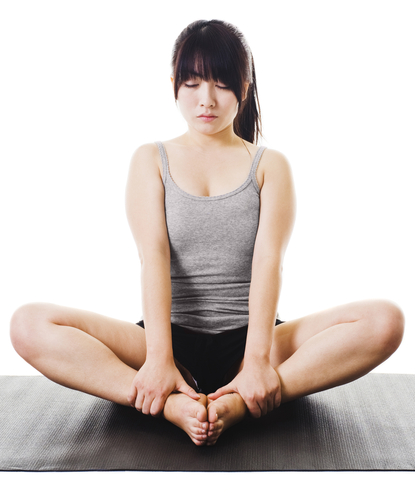Prenatal Yoga – Cobbler’s Pose (Baddha Konasana)
Yoga
Obie Editorial Team
Benefits and Uses
This version of cobbler’s pose is different from its restorative counterpart as it is done from a seated, not reclined, position. While both versions of the pose are fabulous hip openers, the seated version is an active (as opposed to passive) pose that requires the muscles to do a bit of strengthening work in addition to more intense stretching in the hips and back. The pose can also be a nice chest opener and spine lengthener. Try incorporating cobbler’s pose as a cool down from standing poses, towards the latter half of your yoga practice.
Directions
Come to sit on your mat with your spine long and straight. Bend your knees in front of you so that your feet are about a foot in front of your buttocks. Let your knees fall away from one another to each side as you take hold of the outer edges of your feet (and maybe give yourself a nice foot massage!). At this point you will be able to feel whether you can bring your feet closer to your pelvis, or if they need to be further away, creating a larger diamond shape in between your legs. Focus on maintaining the length of the spine, while simultaneously reaching the knees toward the floor to open the hips. Do not force your knees any farther than feels comfortable and do not compromise the length in your spine in order to open your hips more deeply. Imagine reaching your chest upward and forward to create length through your back and chest. If bending forward (forehead towards feet) feels good, feel free to do so, but try not to round your back in the process. Only go so far as feels right for you today.
- Breath: Breath should be full and steady. Ujjayi breath should be used in this pose to calm the mind and inspire relaxation in the pose; it can also be mentally “sent” to any part of the body, likely the hips, to envision creating more space and comfort.
- Modifications: Ideally the knees are below hip level in this pose for the most opening throughout the hips and back. If your knees are higher than your hips, place a blanket or towel under your sitting bones (under your tail bone towards the back of your buttocks), to elevate the hips slightly and accentuate the natural pelvic tilt. This should help you to feel longer in your spine and create more ease when sitting up tall.
- Release: After one relaxing minute or so, use your hands to bring your knees together so that your feet are on the floor. Stretch your legs out in front of you and wiggle your legs to get the blood flowing. Take any other counter movements that would feel good for you.









